-
EXECUTIVE SUMMARY
-
GLOBAL SUBMARINE POWER CABLE MARKET, BY TYPE
-
GLOBAL SUBMARINE POWER CABLE MARKET, BY INSULATION TYPE
-
GLOBAL SUBMARINE POWER CABLE MARKET, BY VOLTAGE
-
GLOBAL SUBMARINE POWER CABLE MARKET, BY CONDUCTOR MATERIAL
-
GLOBAL SUBMARINE POWER CABLE MARKET, BY END-USE
-
GLOBAL SUBMARINE POWER CABLE MARKET, BY REGION
-
MARKET INTRODUCTION
-
DEFINITION
-
SCOPE OF THE STUDY
-
RESEARCH OBJECTIVE
-
MARKET STRUCTURE
-
RESEARCH METHODOLOGY
-
RESEARCH PROCESS
-
PRIMARY RESEARCH
-
SECONDARY RESEARCH
-
MARKET SIZE ESTIMATION
-
FORECAST MODEL
-
LIST OF ASSUMPTIONS
-
MARKET DYNAMICS
-
INTRODUCTION
-
DRIVERS
- RISING NUMBER OF OFFSHORE WIND FARMS
- INCREASING DEMAND IN OFFSHORE OIL & GAS OPERATIONS
-
RESTRAINTS
- HIGH INSTALLATION COST AND REPAIRING COMPLEXITY
-
OPPORTUNITIES
- GROWING DEMAND FOR INTERCOUNTRY AND ISLAND POWER CONNECTIONS
-
IMPACT ANALYSIS OF COVID-19
- IMPACT ON OVERALL POWER INDUSTRY
- IMPACT ON THE SUBMARINE CABLE MARKET
- IMPACT ON SUPPLY CHAIN OF SUBMARINE CABLE MARKET
- IMPACT ON THE MARKET DEMAND FOR SUBMARINE CABLE
- IMPACT ON PRICING OF SUBMARINE CABLE
-
MARKET FACTOR ANALYSIS
-
SUPPLY CHAIN ANALYSIS
- DESIGN & DEVELOPMENT
- RAW MATERIAL & COMPONENT SUPPLY
- MANUFACTURE & ASSEMBLY
- DISTRIBUTION
- END USE
-
PORTER’S FIVE FORCES MODEL
- THREAT OF NEW ENTRANTS
- BARGAINING POWER OF SUPPLIERS
- BARGAINING POWER OF BUYERS
- THREAT OF SUBSTITUTES
- RIVALRY
-
GLOBAL SUBMARINE POWER CABLE MARKET, BY TYPE
-
OVERVIEW
-
SINGLE CORE
-
MULTI CORE
-
GLOBAL SUBMARINE POWER CABLE MARKET, BY INSULATION TYPE
-
OVERVIEW
-
CROSS-LINKED POLYETHYLENE (XLPE)
-
ETHYLENE PROPYLENE RUBBER (EPR)
-
GLOBAL SUBMARINE POWER CABLE MARKET, BY VOLTAGE
-
OVERVIEW
-
UP TO 66 KV
-
66 KV – 220 KV
-
ABOVE 220 KV
-
GLOBAL SUBMARINE POWER CABLE MARKET, BY CONDUCTOR MATERIAL
-
OVERVIEW
-
COPPER
-
ALUMINUM
-
GLOBAL SUBMARINE POWER CABLE MARKET, BY END-USE
-
OVERVIEW
-
OFFSHORE WIND POWER GENERATION
-
OFFSHORE OIL & GAS
-
ISLAND CONNECTION
-
WAVE AND TIDAL POWER GENERATION
-
GLOBAL SUBMARINE POWER CABLE MARKET, BY REGION
-
OVERVIEW
-
NORTH AMERICA
- US
- CANADA
- MEXICO
-
ASIA-PACIFIC
- CHINA
- JAPAN
- MALAYSIA
- INDONESIA
- REST OF ASIA-PACIFIC
-
EUROPE
- GERMANY
- UK
- NORWAY
- DENMARK
- THE NETHERLANDS
- REST OF EUROPE
-
MIDDLE EAST & AFRICA
- SAUDI ARABIA
- UAE
- ANGOLA
- REST OF MIDDLE EAST & AFRICA
-
SOUTH AMERICA
- BRAZIL
- ARGENTINA
- REST OF SOUTH AMERICA
-
COMPETITIVE LANDSCAPE
-
COMPETITIVE OVERVIEW
-
COMPETITIVE BENCHMARKING
-
MARKET SHARE ANALYSIS
-
COMPANY PROFILES
-
PRYSMIAN GROUP
- COMPANY OVERVIEW
- FINANCIAL OVERVIEW
- PRODUCTS OFFERED
- KEY DEVELOPMENTS
- SWOT ANALYSIS
- KEY STRATEGIES
-
NEXANS
- COMPANY OVERVIEW
- FINANCIAL OVERVIEW
- PRODUCTS OFFERED
- KEY DEVELOPMENTS
- SWOT ANALYSIS
- KEY STRATEGIES
-
NKT A/S
- COMPANY OVERVIEW
- FINANCIAL OVERVIEW
- PRODUCTS OFFERED
- KEY DEVELOPMENTS
- SWOT ANALYSIS
- KEY STRATEGIES
-
FURUKAWA ELECTRIC CO., LTD.
- COMPANY OVERVIEW
- FINANCIAL OVERVIEW
- PRODUCTS OFFERED
- KEY DEVELOPMENTS
- SWOT ANALYSIS
- KEY STRATEGIES
-
LS CABLE & SYSTEM LTD
- COMPANY OVERVIEW
- FINANCIAL OVERVIEW
- PRODUCTS OFFERED
- KEY DEVELOPMENTS
- SWOT ANALYSIS
- KEY STRATEGIES
-
SUMITOMO ELECTRIC INDUSTRIES, LTD.
- COMPANY OVERVIEW
- FINANCIAL OVERVIEW
- PRODUCTS OFFERED
- KEY DEVELOPMENTS
-
ZTT
- COMPANY OVERVIEW
- FINANCIAL OVERVIEW
- PRODUCTS OFFERED
- KEY DEVELOPMENTS
-
HENGTONG GROUP CO., LTD.
- COMPANY OVERVIEW
- FINANCIAL OVERVIEW
- PRODUCTS OFFERED
- KEY DEVELOPMENTS
-
QINGDAO HANHE CABLE CO., LTD.
- COMPANY OVERVIEW
- FINANCIAL OVERVIEW
- PRODUCTS OFFERED
- KEY DEVELOPMENTS
-
FUJITSU
- COMPANY OVERVIEW
- FINANCIAL OVERVIEW
- PRODUCTS OFFERED
- KEY DEVELOPMENTS
-
-
LIST OF TABLES
-
LIST OF ASSUMPTIONS
-
GLOBAL SUBMARINE POWER CABLE: MARKET ESTIMATES & FORECAST, BY TYPE, 2023–2032 (USD MILLION)
-
GLOBAL SUBMARINE POWER CABLE: MARKET ESTIMATES & FORECAST, BY INSULATION TYPE, 2023–2032 (USD MILLION)
-
GLOBAL SUBMARINE POWER CABLE: MARKET ESTIMATES & FORECAST, BY VOLTAGE, 2023–2032 (USD MILLION)
-
GLOBAL SUBMARINE POWER CABLE: MARKET ESTIMATES & FORECAST, BY CONDUCTOR MATERIAL, 2023–2032 (USD MILLION)
-
GLOBAL SUBMARINE POWER CABLE: MARKET ESTIMATES & FORECAST, BY END-USE, 2023–2032 (USD MILLION)
-
GLOBAL SUBMARINE POWER CABLE MARKET, BY REGION, 2023–2032 (USD MILLION)
-
NORTH AMERICA: SUBMARINE POWER CABLE MARKET, BY COUNTRY, 2023–2032 (USD MILLION)
-
NORTH AMERICA: SUBMARINE POWER CABLE MARKET ESTIMATES & FORECAST, BY TYPE, 2023–2032 (USD MILLION)
-
NORTH AMERICA: SUBMARINE POWER CABLE MARKET ESTIMATES & FORECAST, BY INSULATION TYPE, 2023–2032 (USD MILLION)
-
NORTH AMERICA: SUBMARINE POWER CABLE MARKET ESTIMATES & FORECAST, BY VOLTAGE, 2023–2032 (USD MILLION)
-
NORTH AMERICA: SUBMARINE POWER CABLE MARKET ESTIMATES & FORECAST, BY CONDUCTOR MATERIAL, 2023–2032 (USD MILLION)
-
NORTH AMERICA: SUBMARINE POWER CABLE MARKET ESTIMATES & FORECAST, BY END-USE, 2023–2032 (USD MILLION)
-
US: SUBMARINE POWER CABLE MARKET ESTIMATES & FORECAST, BY TYPE, 2023–2032 (USD MILLION)
-
US: SUBMARINE POWER CABLE MARKET ESTIMATES & FORECAST, BY INSULATION TYPE, 2023–2032 (USD MILLION)
-
US: SUBMARINE POWER CABLE MARKET ESTIMATES & FORECAST, BY VOLTAGE, 2023–2032 (USD MILLION)
-
US: SUBMARINE POWER CABLE MARKET ESTIMATES & FORECAST, BY CONDUCTOR MATERIAL, 2023–2032 (USD MILLION)
-
US: SUBMARINE POWER CABLE MARKET ESTIMATES & FORECAST, BY END-USE, 2023–2032 (USD MILLION)
-
CANADA: SUBMARINE POWER CABLE MARKET ESTIMATES & FORECAST, BY TYPE, 2023–2032 (USD MILLION)
-
CANADA: SUBMARINE POWER CABLE MARKET ESTIMATES & FORECAST, BY INSULATION TYPE, 2023–2032 (USD MILLION)
-
CANADA: SUBMARINE POWER CABLE MARKET ESTIMATES & FORECAST, BY VOLTAGE, 2023–2032 (USD MILLION)
-
CANADA: SUBMARINE POWER CABLE MARKET ESTIMATES & FORECAST, BY CONDUCTOR MATERIAL, 2023–2032 (USD MILLION)
-
CANADA: SUBMARINE POWER CABLE MARKET ESTIMATES & FORECAST, BY END-USE, 2023–2032 (USD MILLION)
-
MEXICO: SUBMARINE POWER CABLE MARKET ESTIMATES & FORECAST, BY TYPE, 2023–2032 (USD MILLION)
-
MEXICO: SUBMARINE POWER CABLE MARKET ESTIMATES & FORECAST, BY INSULATION TYPE, 2023–2032 (USD MILLION)
-
MEXICO: SUBMARINE POWER CABLE MARKET ESTIMATES & FORECAST, BY VOLTAGE, 2023–2032 (USD MILLION)
-
MEXICO: SUBMARINE POWER CABLE MARKET ESTIMATES & FORECAST, BY CONDUCTOR MATERIAL, 2023–2032 (USD MILLION)
-
MEXICO: SUBMARINE POWER CABLE MARKET ESTIMATES & FORECAST, BY END-USE, 2023–2032 (USD MILLION)
-
ASIA-PACIFIC: SUBMARINE POWER CABLE MARKET, BY COUNTRY, 2023–2032 (USD MILLION)
-
ASIA-PACIFIC: SUBMARINE POWER CABLE MARKET ESTIMATES & FORECAST, BY TYPE, 2023–2032 (USD MILLION)
-
ASIA-PACIFIC: SUBMARINE POWER CABLE MARKET ESTIMATES & FORECAST, BY INSULATION TYPE, 2023–2032 (USD MILLION)
-
ASIA-PACIFIC: SUBMARINE POWER CABLE MARKET ESTIMATES & FORECAST, BY VOLTAGE, 2023–2032 (USD MILLION)
-
ASIA-PACIFIC: SUBMARINE POWER CABLE MARKET ESTIMATES & FORECAST, BY CONDUCTOR MATERIAL, 2023–2032 (USD MILLION)
-
ASIA-PACIFIC: SUBMARINE POWER CABLE MARKET ESTIMATES & FORECAST, BY END-USE, 2023–2032 (USD MILLION)
-
CHINA: SUBMARINE POWER CABLE MARKET ESTIMATES & FORECAST, BY TYPE, 2023–2032 (USD MILLION)
-
CHINA: SUBMARINE POWER CABLE MARKET ESTIMATES & FORECAST, BY INSULATION TYPE, 2023–2032 (USD MILLION)
-
CHINA: SUBMARINE POWER CABLE MARKET ESTIMATES & FORECAST, BY VOLTAGE, 2023–2032 (USD MILLION)
-
CHINA: SUBMARINE POWER CABLE MARKET ESTIMATES & FORECAST, BY CONDUCTOR MATERIAL, 2023–2032 (USD MILLION)
-
CHINA: SUBMARINE POWER CABLE MARKET ESTIMATES & FORECAST, BY END-USE, 2023–2032 (USD MILLION)
-
JAPAN: SUBMARINE POWER CABLE MARKET ESTIMATES & FORECAST, BY TYPE, 2023–2032 (USD MILLION)
-
JAPAN: SUBMARINE POWER CABLE MARKET ESTIMATES & FORECAST, BY INSULATION TYPE, 2023–2032 (USD MILLION)
-
JAPAN: SUBMARINE POWER CABLE MARKET ESTIMATES & FORECAST, BY VOLTAGE, 2023–2032 (USD MILLION)
-
JAPAN: SUBMARINE POWER CABLE MARKET ESTIMATES & FORECAST, BY CONDUCTOR MATERIAL, 2023–2032 (USD MILLION)
-
JAPAN: SUBMARINE POWER CABLE MARKET ESTIMATES & FORECAST, BY END-USE, 2023–2032 (USD MILLION)
-
MALAYSIA: SUBMARINE POWER CABLE MARKET ESTIMATES & FORECAST, BY TYPE, 2023–2032 (USD MILLION)
-
MALAYSIA: SUBMARINE POWER CABLE MARKET ESTIMATES & FORECAST, BY INSULATION TYPE, 2023–2032 (USD MILLION)
-
MALAYSIA: SUBMARINE POWER CABLE MARKET ESTIMATES & FORECAST, BY VOLTAGE, 2023–2032 (USD MILLION)
-
MALAYSIA: SUBMARINE POWER CABLE MARKET ESTIMATES & FORECAST, BY CONDUCTOR MATERIAL, 2023–2032 (USD MILLION)
-
MALAYSIA: SUBMARINE POWER CABLE MARKET ESTIMATES & FORECAST, BY END-USE, 2023–2032 (USD MILLION)
-
INDONESIA: SUBMARINE POWER CABLE MARKET ESTIMATES & FORECAST, BY TYPE, 2023–2032 (USD MILLION)
-
INDONESIA: SUBMARINE POWER CABLE MARKET ESTIMATES & FORECAST, BY INSULATION TYPE, 2023–2032 (USD MILLION)
-
INDONESIA: SUBMARINE POWER CABLE MARKET ESTIMATES & FORECAST, BY VOLTAGE, 2023–2032 (USD MILLION)
-
INDONESIA: SUBMARINE POWER CABLE MARKET ESTIMATES & FORECAST, BY CONDUCTOR MATERIAL, 2023–2032 (USD MILLION)
-
INDONESIA: SUBMARINE POWER CABLE MARKET ESTIMATES & FORECAST, BY END-USE, 2023–2032 (USD MILLION)
-
REST OF ASIA-PACIFIC: SUBMARINE POWER CABLE MARKET ESTIMATES & FORECAST, BY TYPE, 2023–2032 (USD MILLION)
-
REST OF ASIA-PACIFIC: SUBMARINE POWER CABLE MARKET ESTIMATES & FORECAST, BY INSULATION TYPE, 2023–2032 (USD MILLION)
-
REST OF ASIA-PACIFIC: SUBMARINE POWER CABLE MARKET ESTIMATES & FORECAST, BY VOLTAGE, 2023–2032 (USD MILLION)
-
REST OF ASIA-PACIFIC: SUBMARINE POWER CABLE MARKET ESTIMATES & FORECAST, BY CONDUCTOR MATERIAL, 2023–2032 (USD MILLION)
-
REST OF ASIA-PACIFIC: SUBMARINE POWER CABLE MARKET ESTIMATES & FORECAST, BY END-USE, 2023–2032 (USD MILLION)
-
EUROPE: SUBMARINE POWER CABLE MARKET, BY COUNTRY, 2023–2032 (USD MILLION)
-
EUROPE: SUBMARINE POWER CABLE MARKET ESTIMATES & FORECAST, BY TYPE, 2023–2032 (USD MILLION)
-
EUROPE: SUBMARINE POWER CABLE MARKET ESTIMATES & FORECAST, BY INSULATION TYPE, 2023–2032 (USD MILLION)
-
EUROPE: SUBMARINE POWER CABLE MARKET ESTIMATES & FORECAST, BY VOLTAGE, 2023–2032 (USD MILLION)
-
EUROPE: SUBMARINE POWER CABLE MARKET ESTIMATES & FORECAST, BY CONDUCTOR MATERIAL, 2023–2032 (USD MILLION)
-
EUROPE: SUBMARINE POWER CABLE MARKET ESTIMATES & FORECAST, BY END-USE, 2023–2032 (USD MILLION)
-
GERMANY: SUBMARINE POWER CABLE MARKET ESTIMATES & FORECAST, BY TYPE, 2023–2032 (USD MILLION)
-
GERMANY: SUBMARINE POWER CABLE MARKET ESTIMATES & FORECAST, BY INSULATION TYPE, 2023–2032 (USD MILLION)
-
GERMANY: SUBMARINE POWER CABLE MARKET ESTIMATES & FORECAST, BY VOLTAGE, 2023–2032 (USD MILLION)
-
GERMANY: SUBMARINE POWER CABLE MARKET ESTIMATES & FORECAST, BY CONDUCTOR MATERIAL, 2023–2032 (USD MILLION)
-
GERMANY: SUBMARINE POWER CABLE MARKET ESTIMATES & FORECAST, BY END-USE, 2023–2032 (USD MILLION)
-
UK: SUBMARINE POWER CABLE MARKET ESTIMATES & FORECAST, BY TYPE, 2023–2032 (USD MILLION)
-
UK: SUBMARINE POWER CABLE MARKET ESTIMATES & FORECAST, BY INSULATION TYPE, 2023–2032 (USD MILLION)
-
UK: SUBMARINE POWER CABLE MARKET ESTIMATES & FORECAST, BY VOLTAGE, 2023–2032 (USD MILLION)
-
UK: SUBMARINE POWER CABLE MARKET ESTIMATES & FORECAST, BY CONDUCTOR MATERIAL, 2023–2032 (USD MILLION)
-
UK: SUBMARINE POWER CABLE MARKET ESTIMATES & FORECAST, BY END-USE, 2023–2032 (USD MILLION)
-
NORWAY: SUBMARINE POWER CABLE MARKET ESTIMATES & FORECAST, BY TYPE, 2023–2032 (USD MILLION)
-
NORWAY: SUBMARINE POWER CABLE MARKET ESTIMATES & FORECAST, BY INSULATION TYPE, 2023–2032 (USD MILLION)
-
NORWAY: SUBMARINE POWER CABLE MARKET ESTIMATES & FORECAST, BY VOLTAGE, 2023–2032 (USD MILLION)
-
NORWAY: SUBMARINE POWER CABLE MARKET ESTIMATES & FORECAST, BY CONDUCTOR MATERIAL, 2023–2032 (USD MILLION)
-
NORWAY: SUBMARINE POWER CABLE MARKET ESTIMATES & FORECAST, BY END-USE, 2023–2032 (USD MILLION)
-
DENMARK: SUBMARINE POWER CABLE MARKET ESTIMATES & FORECAST, BY TYPE, 2023–2032 (USD MILLION)
-
DENMARK: SUBMARINE POWER CABLE MARKET ESTIMATES & FORECAST, BY INSULATION TYPE, 2023–2032 (USD MILLION)
-
DENMARK: SUBMARINE POWER CABLE MARKET ESTIMATES & FORECAST, BY VOLTAGE, 2023–2032 (USD MILLION)
-
DENMARK: SUBMARINE POWER CABLE MARKET ESTIMATES & FORECAST, BY CONDUCTOR MATERIAL, 2023–2032 (USD MILLION)
-
DENMARK: SUBMARINE POWER CABLE MARKET ESTIMATES & FORECAST, BY END-USE, 2023–2032 (USD MILLION)
-
THE NETHERLANDS: SUBMARINE POWER CABLE MARKET ESTIMATES & FORECAST, BY TYPE, 2023–2032 (USD MILLION)
-
THE NETHERLANDS: SUBMARINE POWER CABLE MARKET ESTIMATES & FORECAST, BY INSULATION TYPE, 2023–2032 (USD MILLION)
-
THE NETHERLANDS: SUBMARINE POWER CABLE MARKET ESTIMATES & FORECAST, BY VOLTAGE, 2023–2032 (USD MILLION)
-
THE NETHERLANDS: SUBMARINE POWER CABLE MARKET ESTIMATES & FORECAST, BY CONDUCTOR MATERIAL, 2023–2032 (USD MILLION)
-
THE NETHERLANDS: SUBMARINE POWER CABLE MARKET ESTIMATES & FORECAST, BY END-USE, 2023–2032 (USD MILLION)
-
REST OF EUROPE: SUBMARINE POWER CABLE MARKET ESTIMATES & FORECAST, BY TYPE, 2023–2032 (USD MILLION)
-
REST OF EUROPE: SUBMARINE POWER CABLE MARKET ESTIMATES & FORECAST, BY INSULATION TYPE, 2023–2032 (USD MILLION)
-
REST OF EUROPE: SUBMARINE POWER CABLE MARKET ESTIMATES & FORECAST, BY VOLTAGE, 2023–2032 (USD MILLION)
-
REST OF EUROPE: SUBMARINE POWER CABLE MARKET ESTIMATES & FORECAST, BY CONDUCTOR MATERIAL, 2023–2032 (USD MILLION)
-
REST OF EUROPE: SUBMARINE POWER CABLE MARKET ESTIMATES & FORECAST, BY END-USE, 2023–2032 (USD MILLION)
-
MIDDLE EAST & AFRICA: SUBMARINE POWER CABLE MARKET, BY COUNTRY, 2023–2032 (USD MILLION)
-
MIDDLE EAST & AFRICA: SUBMARINE POWER CABLE MARKET ESTIMATES & FORECAST, BY TYPE, 2023–2032 (USD MILLION)
-
MIDDLE EAST & AFRICA: SUBMARINE POWER CABLE MARKET ESTIMATES & FORECAST, BY INSULATION TYPE, 2023–2032 (USD MILLION)
-
MIDDLE EAST & AFRICA: SUBMARINE POWER CABLE MARKET ESTIMATES & FORECAST, BY VOLTAGE, 2023–2032 (USD MILLION)
-
MIDDLE EAST & AFRICA: SUBMARINE POWER CABLE MARKET ESTIMATES & FORECAST, BY CONDUCTOR MATERIAL, 2023–2032 (USD MILLION)
-
MIDDLE EAST & AFRICA: SUBMARINE POWER CABLE MARKET ESTIMATES & FORECAST, BY END USE, 2023–2032 (USD MILLION)
-
SAUDI ARABIA: SUBMARINE POWER CABLE MARKET ESTIMATES & FORECAST, BY TYPE, 2023–2032 (USD MILLION)
-
SAUDI ARABIA: SUBMARINE POWER CABLE MARKET ESTIMATES & FORECAST, BY INSULATION TYPE, 2023–2032 (USD MILLION)
-
SAUDI ARABIA: SUBMARINE POWER CABLE MARKET ESTIMATES & FORECAST, BY VOLTAGE, 2023–2032 (USD MILLION)
-
SAUDI ARABIA: SUBMARINE POWER CABLE MARKET ESTIMATES & FORECAST, BY CONDUCTOR MATERIAL, 2023–2032 (USD MILLION)
-
SAUDI ARABIA: SUBMARINE POWER CABLE MARKET ESTIMATES & FORECAST, BY END USE, 2023–2032 (USD MILLION)
-
UAE: SUBMARINE POWER CABLE MARKET ESTIMATES & FORECAST, BY TYPE, 2023–2032 (USD MILLION)
-
UAE: SUBMARINE POWER CABLE MARKET ESTIMATES & FORECAST, BY INSULATION TYPE, 2023–2032 (USD MILLION)
-
UAE: SUBMARINE POWER CABLE MARKET ESTIMATES & FORECAST, BY VOLTAGE, 2023–2032 (USD MILLION)
-
UAE: SUBMARINE POWER CABLE MARKET ESTIMATES & FORECAST, BY CONDUCTOR MATERIAL, 2023–2032 (USD MILLION)
-
UAE: SUBMARINE POWER CABLE MARKET ESTIMATES & FORECAST, BY END USE, 2023–2032 (USD MILLION)
-
ANGOLA: SUBMARINE POWER CABLE MARKET ESTIMATES & FORECAST, BY TYPE, 2023–2032 (USD MILLION)
-
ANGOLA: SUBMARINE POWER CABLE MARKET ESTIMATES & FORECAST, BY INSULATION TYPE, 2023–2032 (USD MILLION)
-
ANGOLA: SUBMARINE POWER CABLE MARKET ESTIMATES & FORECAST, BY VOLTAGE, 2023–2032 (USD MILLION)
-
ANGOLA: SUBMARINE POWER CABLE MARKET ESTIMATES & FORECAST, BY CONDUCTOR MATERIAL, 2023–2032 (USD MILLION)
-
ANGOLA: SUBMARINE POWER CABLE MARKET ESTIMATES & FORECAST, BY END USE, 2023–2032 (USD MILLION)
-
REST OF MIDDLE EAST & AFRICA: SUBMARINE POWER CABLE MARKET ESTIMATES & FORECAST, BY TYPE, 2023–2032 (USD MILLION)
-
REST OF MIDDLE EAST & AFRICA: SUBMARINE POWER CABLE MARKET ESTIMATES & FORECAST, BY INSULATION TYPE, 2023–2032 (USD MILLION)
-
REST OF MIDDLE EAST & AFRICA: SUBMARINE POWER CABLE MARKET ESTIMATES & FORECAST, BY VOLTAGE, 2023–2032 (USD MILLION)
-
REST OF MIDDLE EAST & AFRICA: SUBMARINE POWER CABLE MARKET ESTIMATES & FORECAST, BY CONDUCTOR MATERIAL, 2023–2032 (USD MILLION)
-
REST OF MIDDLE EAST & AFRICA: SUBMARINE POWER CABLE MARKET ESTIMATES & FORECAST, BY END USE, 2023–2032 (USD MILLION)
-
SOUTH AMERICA: GLOBAL SUBMARINE POWER CABLE MARKET, BY COUNTRY, 2023–2032 (USD MILLION)
-
SOUTH AMERICA: SUBMARINE POWER CABLE MARKET ESTIMATES & FORECAST, BY TYPE, 2023–2032 (USD MILLION)
-
SOUTH AMERICA: SUBMARINE POWER CABLE MARKET ESTIMATES & FORECAST, BY INSULATION TYPE, 2023–2032 (USD MILLION)
-
SOUTH AMERICA: SUBMARINE POWER CABLE MARKET ESTIMATES & FORECAST, BY VOLTAGE, 2023–2032 (USD MILLION)
-
SOUTH AMERICA: SUBMARINE POWER CABLE MARKET ESTIMATES & FORECAST, BY CONDUCTOR MATERIAL, 2023–2032 (USD MILLION)
-
SOUTH AMERICA: SUBMARINE POWER CABLE MARKET ESTIMATES & FORECAST, BY END USE, 2023–2032 (USD MILLION)
-
BRAZIL: SUBMARINE POWER CABLE MARKET ESTIMATES & FORECAST, BY TYPE, 2023–2032 (USD MILLION)
-
BRAZIL: SUBMARINE POWER CABLE MARKET ESTIMATES & FORECAST, BY INSULATION TYPE, 2023–2032 (USD MILLION)
-
BRAZIL: SUBMARINE POWER CABLE MARKET ESTIMATES & FORECAST, BY VOLTAGE, 2023–2032 (USD MILLION)
-
BRAZIL: SUBMARINE POWER CABLE MARKET ESTIMATES & FORECAST, BY CONDUCTOR MATERIAL, 2023–2032 (USD MILLION)
-
BRAZIL: SUBMARINE POWER CABLE MARKET ESTIMATES & FORECAST, BY END USE, 2023–2032 (USD MILLION)
-
ARGENTINA: SUBMARINE POWER CABLE MARKET ESTIMATES & FORECAST, BY TYPE, 2023–2032 (USD MILLION)
-
ARGENTINA: SUBMARINE POWER CABLE MARKET ESTIMATES & FORECAST, BY INSULATION TYPE, 2023–2032 (USD MILLION)
-
ARGENTINA: SUBMARINE POWER CABLE MARKET ESTIMATES & FORECAST, BY VOLTAGE, 2023–2032 (USD MILLION)
-
ARGENTINA: SUBMARINE POWER CABLE MARKET ESTIMATES & FORECAST, BY CONDUCTOR MATERIAL, 2023–2032 (USD MILLION)
-
ARGENTINA: SUBMARINE POWER CABLE MARKET ESTIMATES & FORECAST, BY END USE, 2023–2032 (USD MILLION)
-
REST OF SOUTH AMERICA: SUBMARINE POWER CABLE MARKET ESTIMATES & FORECAST, BY TYPE, 2023–2032 (USD MILLION)
-
REST OF SOUTH AMERICA: SUBMARINE POWER CABLE MARKET ESTIMATES & FORECAST, BY INSULATION TYPE, 2023–2032 (USD MILLION)
-
REST OF SOUTH AMERICA: SUBMARINE POWER CABLE MARKET ESTIMATES & FORECAST, BY VOLTAGE, 2023–2032 (USD MILLION)
-
REST OF SOUTH AMERICA: SUBMARINE POWER CABLE MARKET ESTIMATES & FORECAST, BY CONDUCTOR MATERIAL, 2023–2032 (USD MILLION)
-
REST OF SOUTH AMERICA: SUBMARINE POWER CABLE MARKET ESTIMATES & FORECAST, BY END USE, 2023–2032 (USD MILLION)
-
PRYSMIAN GROUP: PRODUCTS OFFERED
-
PRYSMIAN GROUP: KEY DEVELOPMENTS
-
NEXANS: PRODUCTS OFFERED
-
NEXANS: KEY DEVELOPMENTS
-
NKT A/S: PRODUCTS OFFERED
-
NKT A/S: KEY DEVELOPMENTS
-
FURUKAWA ELECTRIC CO., LTD.: PRODUCTS OFFERED
-
FURUKAWA ELECTRIC CO., LTD.: KEY DEVELOPMENTS
-
LS CABLE & SYSTEM LTD.: PRODUCTS OFFERED
-
LS CABLE & SYSTEM LTD.: KEY DEVELOPMENTS
-
SUMITOMO ELECTRIC INDUSTRIES, LTD.: PRODUCTS OFFERED
-
SUMITOMO ELECTRIC INDUSTRIES, LTD.: KEY DEVELOPMENTS
-
ZTT: PRODUCTS OFFERED
-
ZTT: KEY DEVELOPMENTS
-
HENGTONG GROUP CO., LTD.: PRODUCTS OFFERED
-
HENGTONG GROUP CO., LTD.: KEY DEVELOPMENTS
-
QINGDAO HANHE CABLE CO., LTD.: PRODUCTS OFFERED
-
QINGDAO HANHE CABLE CO., LTD.: KEY DEVELOPMENTS
-
FUJITSU: PRODUCTS OFFERED
-
-
LIST OF FIGURES
-
MARKET SYNOPSIS
-
GLOBAL SUBMARINE POWER CABLE MARKET ANALYSIS, BY TYPE
-
GLOBAL SUBMARINE POWER CABLE MARKET ANALYSIS, BY INSULATION TYPE
-
GLOBAL SUBMARINE POWER CABLE MARKET ANALYSIS, BY VOLTAGE
-
GLOBAL SUBMARINE POWER CABLE MARKET ANALYSIS, BY CONDUCTOR MATERIAL
-
GLOBAL SUBMARINE POWER CABLE MARKET ANALYSIS, BY END-USE
-
GLOBAL SUBMARINE POWER CABLE MARKET ANALYSIS, BY REGION
-
GLOBAL SUBMARINE POWER CABLE MARKET: STRUCTURE
-
RESEARCH PROCESS
-
TOP-DOWN & BOTTOM-UP APPROACHES
-
DRO ANALYSIS: GLOBAL SUBMARINE POWER CABLE MARKET
-
SUPPLY CHAIN ANALYSIS: GLOBAL SUBMARINE POWER CABLE MARKET
-
PORTER'S FIVE FORCES ANALYSIS: GLOBAL SUBMARINE POWER CABLE MARKET
-
GLOBAL SUBMARINE POWER CABLE MARKET, BY TYPE, 2032 (% SHARE)
-
GLOBAL SUBMARINE POWER CABLE MARKET, BY INSULATION TYPE, 2032 (% SHARE)
-
GLOBAL SUBMARINE POWER CABLE MARKET, BY VOLTAGE, 2032 (% SHARE)
-
GLOBAL SUBMARINE POWER CABLE MARKET, BY CONDUCTOR MATERIAL, 2032 (% SHARE)
-
GLOBAL SUBMARINE POWER CABLE MARKET, BY END-USE, 2032 (% SHARE)
-
GLOBAL SUBMARINE POWER CABLE MARKET, BY REGION, 2032 (% SHARE)
-
BENCHMARKING OF MAJOR COMPETITORS
-
GLOBAL SUBMARINE POWER CABLES MARKET SHARE ANALYSIS, 2032
-
PRYSMIAN GROUP: FINANCIAL OVERVIEW SNAPSHOT
-
PRYSMIAN GROUP: SWOT ANALYSIS
-
NEXANS: FINANCIAL OVERVIEW SNAPSHOT
-
NEXANS: SWOT ANALYSIS
-
NKT A/S: FINANCIAL OVERVIEW SNAPSHOT
-
NKT A/S: SWOT ANALYSIS
-
FURUKAWA ELECTRIC CO., LTD.: FINANCIAL OVERVIEW SNAPSHOT
-
FURUKAWA ELECTRIC CO., LTD.: SWOT ANALYSIS
-
LS CABLE & SYSTEM LTD.: FINANCIAL OVERVIEW SNAPSHOT
-
LS CABLE & SYSTEM LTD.: SWOT ANALYSIS
-
SUMITOMO ELECTRIC INDUSTRIES, LTD.: FINANCIAL OVERVIEW SNAPSHOT
-
FUJITSU: FINANCIAL OVERVIEW SNAPSHOT
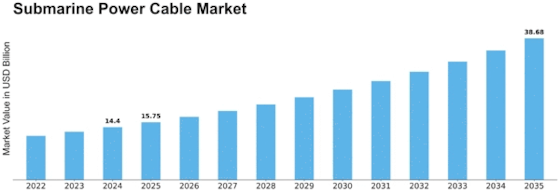

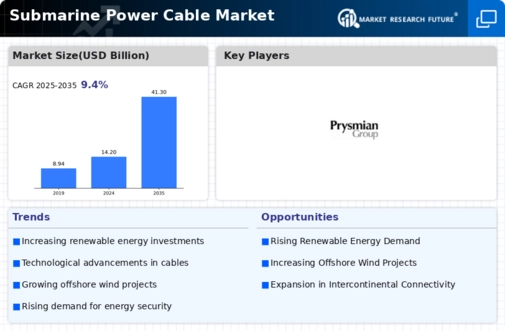

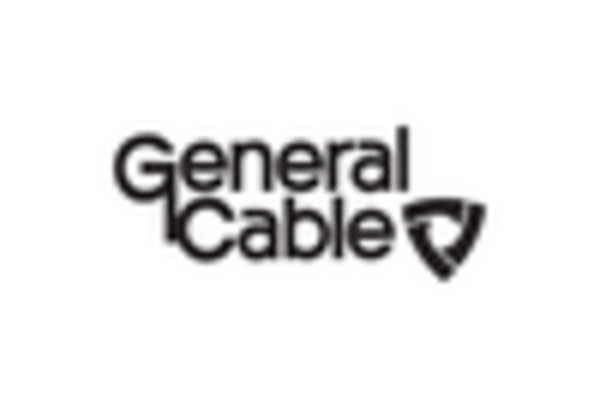

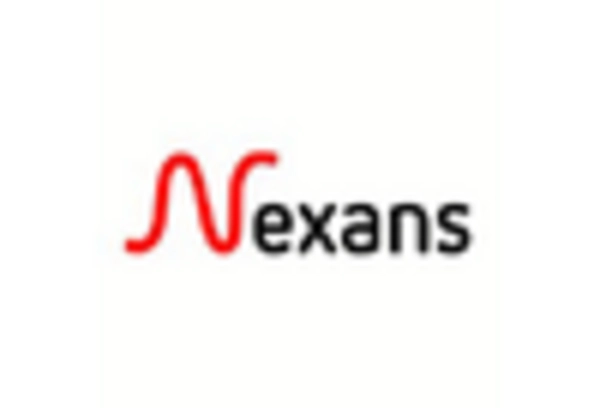
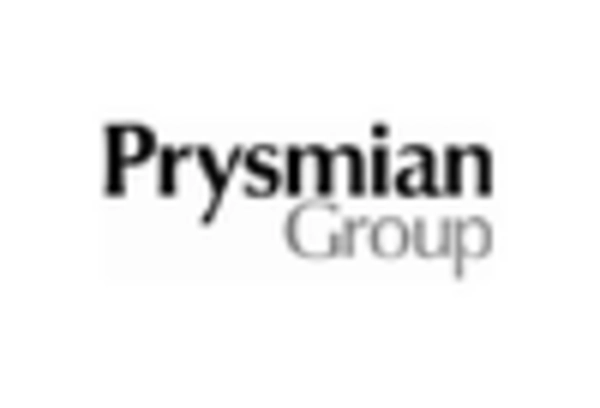
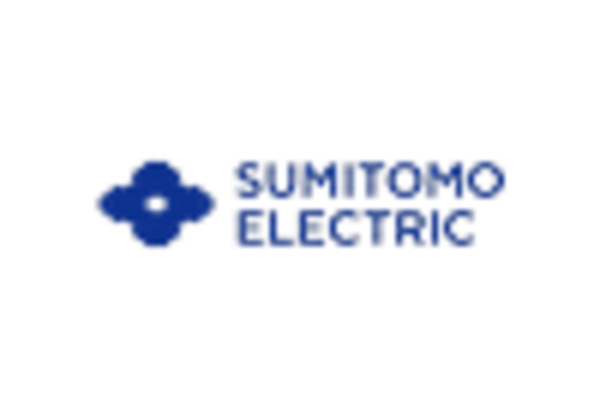

Leave a Comment